How Much is Too Much? GT350 Just Right
By John Gilbert
Car-buyers have made a dedicated swing to trucks and SUVs, but there remains a market for cars, and within that segment is a stubborn sub-market for hot cars. High-performance cars. Fun cars.
For a week, I had the chance to live with one — a 2019 Mustang GT350, in “race red,” which is a slightly more subtle name than “arrest-me red,” but the same implied warning accompanies this sleek, fastback descendent of the original Mustang-inspired ponycar craze of the 1960s and ’70s. The shape of all those is roughly the same, whether you preferred the Mustang, Camaro, Challenger, or the old-breed Firebird Trans-Am, Barracuda, or Javelin. All shared a long hood, short rear deck, fast-sloping roofline, and room for two in the front buckets and only those who will put up with the pain of limited legroom in the rear for the thrill of going for a drive.
Driving the Shelby GT350 is thrilling, starting just by starting. Make sure the clutch is in on the 6-speed stick shift, then hit the push-button starter and the crackling roar of the engine gives you a bit of a chil. Rev it and it sounds better, and flip the little toggle switch at the far right of the lower center-stack panel, the one with the little icon of dual exhaust pipes, from normal to “sport,” and the sound changes from light, grey-cloud thunder to dark, almost black, severe-weather thunderclaps of ground-shaking roar.
Having fiddled with various other switches to get to sport — but maybe not race or track-day — you take off, with the acceleration pushing you back into those form-fitting Recaro bucket seats, which encapsulate you in all manner of turns and twists. Those thrills are there, included and waiting for you, in every Shelby GT350. And still, I was able to coax it up from the normal 16-miles-per-gallon in city driving to a peak of 22 mpg on a freeway trip from Duluth to Minneapolis and back to Duluth, including a few slaloms around construction barrels.
The GT350 gets its startling power from a 5.2-liter, dual-overhead-camshaft V8, normally aspirated, with the flat-plane-crankshaft engine turning out 526 horsepower at 7,000 RPMs, and 429 foot-pounds of torque. That is an impressive amount of power, regardless of your intentions, even if you realize you can get a supercharged version of the same engine in the still newer Shelby GT500 — with a ludicrous 750 horsepower and 700 foot-pounds of torque.
As it is, the GT350 takes the sticker price up to $64,860. Such is the cost of precise engineering refinement these days. Almost as much as a loaded pickup truck!
Just like in the Muscle-car days of yore, the “Big Three” are in hot competition. Ford has clearly been influenced by Dodge, which shocked hot-car buyers with a Challenger Hellcat, then upgraded to a Demon, and then a still-hotter Redeye, with a monster supercharged 6.2-liter, 797 horsepower, 707 foot-pound screamer. Chevrolet was scurrying to build a hotter Camaro with the Corvette engine, and now a new mid-engined Corvette, so Dodge kept upping the ante to keep its spot atop the power tests.
Ford, naturally, was not about to concede anything, so it brought out the new Shelby models.
There is a little nostalgia involved, whenever I drive a Mustang Shelby GT350, and my most recent occasion was a gorgeous week in mid-August, where the blue of Lake Superior’s water and the sky rising up from the Wisconsin horizon harmonized, just as the newest GT350 seemed properly frisky for harmonized with the curves of the North Shore Drive.
The nostalgia dates back to the mid-1970s, when my wife, Joan, and I, decided between buying a Shelby Mustang GT350, or a new 1970 Boss 302 Mustang. Tough decision, until I drove a Boss 302 and it won out as a “family car” for our young family. We drove it hard, but not abusively hard. We put a lot of miles on it in a few short years, and I had gotten it repainted into the Dodge hot color of the day, a dark purple called “Plum Crazy.” The Vikings would have loved it.
Writing at the Minneapolis Tribune at the time, I was driving out to Fairmont to do a late-summer feature on the thriving dirt-track stock car racing facility there. I stopped for a flagman at a road-construction site, and was rear-ended by a large truck, whose driver had neglected to pay attention, or to hit his brakes, after he belatedly realized the car ahead of him was stopped. I let out the clutch like a drag-racer and lurched forward in a 20-foot burnout before the impact, which probably saved my life. Saved most of the car, too, although the left rear corner was turned to shrapnel. Amazingly, a shop in Blue Earth was able to pry and bend the metal to clear the spare tire by enough so I was could limp back to the Twin Cities.
The insurance company declared the car totaled, and my feelings were soothed when I found a 1969 Shelby GT350 that had not been treated well. The engine was a 351 V8, not the “hot” Cleveland engine, but the mundane Windsor 351, dressed up with flashy valve covers. We were able to buy the Shelby GT350 and hire Bill Schifsky — who raced a Funny Car out of White Bear Lake — to do the transplant in his high-performance shot, all out of the insurance settlement.
We had a custom paint job on the car: four coats of white over four coats of black, and then eight coats of cobalt blue over the whole thing. If you could get that paint job today, it would cost $10,000, at least. Anyhow, no Shelby GT350 ever had an engine like that sizzling Boss 302, and the performance clutch and suspension improved with Kona shocks, all under the sleek fiberglass Shelby body.
Through the years, I’ve driven and written about every Shelby model that has come along, and we didn’t sell our “Boss/Shelby” until Ford had vaulted into the modern era by leaving the pushrod-engine-powered competition behind and engineering a dual-overhead-camshaft V8 that made the Mustang sing. It wasn’t quite as swift as the Boss 302, but it was technically advanced enough that we could part with our beloved car, even though it was like selling the third son Joan and I never had.
The new fleet of Mustangs are of particular interest, because Ford has said it was going to stop producing most of its cars, turning those plants into SUV-makers. The Taurus, the Fusion, and even the Focus and Fiesta are all headed for closeout status, and the only car Ford will continue making will be the Mustang.
At least that consists of a pretty thorough array. You can get a base Mustang with a 2.3-liter turbo 4-cylinder that has 320 horsepower, move up the high-performance steps to the Ford GT, with beefed up suspension and a 5.0-liter DOHC V8 with 460 horsepower and 420 foot-pounds of torque. Next up is the Bullitt, a well-balanced and fun machine with the same 5.0-liter V8 up to 480 horsepower and 420 foot-pounds. Then comes the GT350, switching to the hotter, more high-tech flat-plane-crank 5.2-liter V8, also with dual overhead cams, and 526 horsepower with 429 foot-pounds of torque. Up on top is the GT500, with the same 5.2 V8 engine but supercharged up to 760 horses and 700 foot-pounds.
I have not yet driven the GT500, but impressive as its numbers are, the figures attained with a normally aspirated 5.2 is an engineering gem. Car and Driver magazine did a recent comparison in performance between the Camaro SS1LE and the Mustang GT, and it gave the nod to the Camaro. Interesting. The Camaro had a 6.2-liter pushrod V8 with 455 horsepower at 6,000 RPMs, while the Mustang had the 5.0-liter V8 with 460 horsepower at 7,000 RPMs. Nowhere do they point out that with dual-overhead cams, the Mustang can give up more than a full liter of displacement and still produce more horsepower at higher revs.
In addition, they could have moved up to the Bullitt for 20 more horses, or to Ford’s flat-plane-crank 5.2 V8 in the GT350 for still more. I will eagerly await the chance to drive the GT500, although the runaway power fight at the top of the rejuvenated muscle-car battle has gotten out of control, I’d say.
But except for that muscle escalation, I would say the GT350 has just about the right combination of stay-alert power and performance handling, while the GT500 seems to be over-the-top for power. The feel, refinement, and comfort of the seats — front, at least — and the steering/handling, exhilarating sound, plus the look, make the GT350 the perfect car for Ford fanatics, muscle-car fanatics, and one-upmanship gambits.
And did I mention nostalgia?


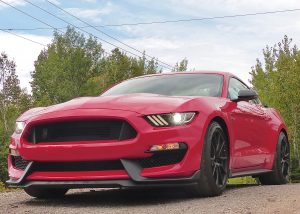
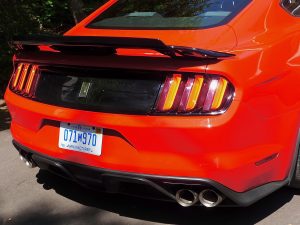
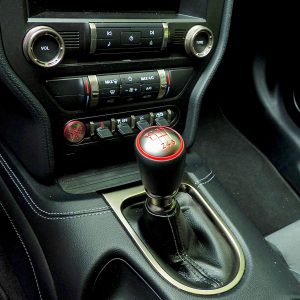
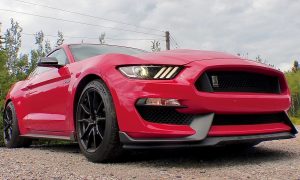
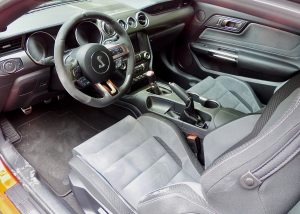
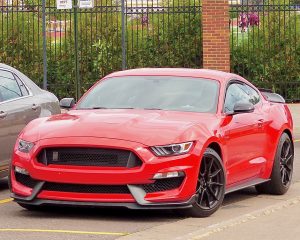
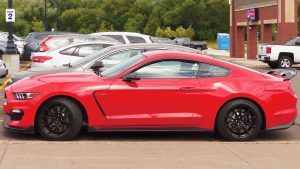
 John Gilbert is a lifetime Minnesotan and career journalist, specializing in cars and sports during and since spending 30 years at the Minneapolis Tribune, now the Star Tribune. More recently, he has continued translating the high-tech world of autos and sharing his passionate insights as a freelance writer/photographer/broadcaster. A member of the prestigious North American Car and Truck of the Year jury since 1993. John can be heard Monday-Friday from 9-11am on 610 KDAL(www.kdal610.com) on the "John Gilbert Show," and writes a column in the Duluth Reader.
John Gilbert is a lifetime Minnesotan and career journalist, specializing in cars and sports during and since spending 30 years at the Minneapolis Tribune, now the Star Tribune. More recently, he has continued translating the high-tech world of autos and sharing his passionate insights as a freelance writer/photographer/broadcaster. A member of the prestigious North American Car and Truck of the Year jury since 1993. John can be heard Monday-Friday from 9-11am on 610 KDAL(www.kdal610.com) on the "John Gilbert Show," and writes a column in the Duluth Reader.